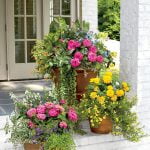Are you looking for creative and unique ways to bring nature into your home or garden? Look no further than miniature gardens. In this article, we will explore a variety of miniature garden ideas, from choosing the right container to designing and maintaining your own tiny green oasis. Whether you are a seasoned gardener or just starting out, there are countless possibilities for creating your own miniature garden masterpiece.
When it comes to miniature gardens, the possibilities are endless. From fairy gardens to zen gardens, there is a wide range of styles and designs to choose from. In this article, we will provide you with inspiration and tips for crafting your very own miniature garden that suits your style and preferences. Whether you have limited outdoor space or simply want to bring a touch of nature indoors, miniature gardens offer a creative way to showcase your gardening passion.
In the following sections, we will delve into the key aspects of creating and maintaining a miniature garden. From choosing the right container and plants to adding decorative elements and seasonal variations, we will guide you through the process of designing and displaying your miniature garden. So let’s get started on this enchanting journey into the world of miniature gardening.
Choosing the Right Container for Your Miniature Garden
When it comes to creating a miniature garden, choosing the right container is essential for the success of your project. The container not only serves as the foundation for your miniature garden but also determines the overall look and feel of your garden. There are various factors to consider when selecting the perfect container for your miniature garden, including size, material, and drainage.
Size
The size of your container will depend on the space you have available and the types of plants you want to include in your miniature garden. If you’re working with limited space, consider using smaller containers such as teacups, mason jars, or terrariums. For larger spaces, opt for bigger containers like troughs, wooden crates, or ceramic pots.
Material
Containers come in a variety of materials, each with its own advantages and disadvantages. Clay pots provide good insulation for plant roots but can be prone to cracking in extreme temperatures. Plastic containers are lightweight and easy to move around, but they may not offer as much insulation as other materials. Consider the climate in which you live and choose a material that will best suit your plants’ needs.
Drainage
Proper drainage is crucial for the health of your miniature garden’s plants. Choose a container with drainage holes at the bottom to prevent water from collecting and causing root rot. If your chosen container does not have drainage holes, consider drilling them yourself or placing a layer of gravel at the bottom before adding soil.
Ultimately, the right container for your miniature garden will be one that complements your design aesthetic while also providing a healthy environment for your plants to thrive. Keep these factors in mind as you select the perfect container for your miniature garden ideas.
Types of Plants for Miniature Gardens
When it comes to creating a beautiful and thriving miniature garden, the choice of plants is crucial. Selecting the right types of plants for your miniature garden can make all the difference in ensuring its success. Here are some key considerations and ideas for choosing the best plants for your miniature garden.
Consider Plant Size and Proportion
One important factor to keep in mind when selecting plants for your miniature garden is their size and proportion. Since miniature gardens are small in scale, it’s essential to choose plants that won’t outgrow the space quickly. Look for compact or slow-growing varieties that will maintain their size and not overcrowd the container. Consider using plants with different heights and textures to create visual interest and balance within your miniature garden.
Choose Plants That Thrive Indoors
Many miniature gardens are kept indoors, so it’s essential to select plants that will thrive in an indoor environment. Look for species that tolerate low light conditions if your miniature garden will be located in a room with limited natural sunlight. Succulents, ferns, mosses, and small tropical plants are great choices for indoor miniature gardens as they can adapt well to indoor conditions.
Create a Theme With Your Plant Selection
Get creative with your plant selection by choosing species that fit a specific theme or style for your miniature garden. For example, you could create a desert-themed miniature garden using succulents and cacti, or a fairy-tale-inspired garden with delicate flowering plants and ornamental grasses. Think about the atmosphere you want to evoke with your miniature garden and select plant varieties that help bring that vision to life.
By carefully considering the types of plants you use in your miniature garden, you can create a stunning and cohesive design that will thrive for years to come. Whether indoors or outdoors, incorporating a variety of plant sizes, indoor-friendly species, and thematic selections will help bring your miniature garden ideas to life in a beautiful way.
Designing Your Miniature Garden
Miniature gardens are a charming and creative way to bring the beauty of nature indoors or enhance outdoor spaces. Designing your miniature garden is an exciting part of the process, where you get to let your creativity shine. Whether you want a fairy garden, a desert landscape, or a formal English garden, there are endless possibilities for designing your miniature garden.
When it comes to designing your miniature garden, consider the following tips:
- Theme: Decide on a theme for your miniature garden. This could be a beach scene, a woodland forest, or even a tropical paradise.
- Layout: Consider the layout of your miniature garden. Think about the placement of plants, pathways, and decorative elements to create visual interest.
- Focal Point: Every miniature garden should have a focal point. This could be a small bench, a tiny pond, or even a miniature house.
Once you have a clear vision for your miniature garden, it’s time to start bringing it to life. Consider the scale and proportion of your plants and decorations as you arrange them in your chosen container. Remember to have fun with it and let your imagination run wild. Incorporating unique elements such as miniatures figures or themed accessories can personalize your creation.
Designing your miniature garden is all about creating a magical and enchanting world within a small space. By carefully planning the layout, selecting appropriate plants and decorative elements, and adding personal touches that reflect your style and creativity – you can bring any type of landscape into this small-scale setting.
Ultimately, creative design ideas are essential when working on any type of arrangement; consider incorporating different heights with plants as well as unique shapes in containers for added intrigue.
Adding Decorative Elements to Your Miniature Garden
When it comes to creating a captivating and enchanting miniature garden, adding decorative elements can take your creation to the next level. These small details can bring personality and character to your mini landscape, making it truly unique. Here are some creative ideas for adding decorative elements to your miniature garden:
1. Miniature Furniture: To create a cozy and inviting atmosphere in your miniature garden, consider adding tiny furniture pieces such as benches, chairs, tables, and even hammocks. These furnishings can be made from materials like wood, metal, or resin, and come in various styles and designs to suit the theme of your mini garden.
2. Fairy Accessories: If you want to infuse a touch of whimsy and fantasy into your miniature garden, fairy accessories such as fairy houses, bridges, swings, and lanterns are perfect choices. These charming elements will evoke a sense of magic and enchantment in your mini paradise.
3. Pathways and Signage: Enhance the visual appeal of your miniature garden by incorporating pathways made from pebbles, gravel, or small stones. You can also add miniature signs with cute messages or directional arrows to guide imaginary visitors through the magical landscape.
4. Water Features: For a serene and tranquil ambiance in your miniature garden, consider including water features like tiny ponds, streams, or fountains. These features can be created using small containers filled with water or by using reflective materials like glass marbles to simulate sparkling water.
By incorporating these decorative elements into your miniature garden design, you can elevate the charm and allure of your tiny world. Whether you opt for whimsical fairy accessories or realistic furniture pieces, these details will add depth and personality to your mini oasis. Experiment with different combinations of decorative elements to bring your miniature garden ideas to life in a delightful way.
Maintenance Tips for Miniature Gardens
Miniature gardens are not only charming and beautiful, they are also relatively easy to maintain. With the right care, your mini garden can thrive and bring joy for a long time. Here are some maintenance tips to keep your miniature garden healthy and stunning.
First, it is important to regularly check your miniature garden for any signs of pests or diseases. Keep an eye out for yellowing leaves, holes in the foliage, or any unusual spots on the plants. If you notice any of these issues, take action immediately to prevent further damage.
Secondly, proper watering is crucial for the success of your miniature garden. Overwatering can lead to root rot, while underwatering can cause the plants to wither and die. Make sure to water your mini garden according to the specific needs of the plants you have chosen. Some plants may require more frequent watering, while others may be more tolerant of dry conditions.
Lastly, regular pruning and grooming will help maintain the shape and overall appearance of your miniature garden. Trim back any overgrown plants or remove dead foliage to keep your mini garden looking neat and tidy.
| Maintenance Tips | Details |
|---|---|
| Pest control | Regularly check for signs of pests and diseases |
| Watering | Proper watering is crucial for success |
| Pruning | Regular pruning and grooming will help maintain appearance |
Seasonal Miniature Garden Ideas
Creating a miniature garden can be a fun and enjoyable hobby, but it’s even more exciting when you change it up with the seasons. Seasonal miniature gardens can bring a touch of nature and festive cheer to your home all year round. Whether it’s spring, summer, fall, or winter, there are plenty of creative ideas for transforming your miniature garden to match the season.
In the spring, consider adding tiny blooming flowers like daffodils, tulips, or cherry blossoms to represent the season of renewal and growth. You can also incorporate small decorative items such as colorful Easter eggs or little bunnies to celebrate the holiday. For the summer season, opt for vibrant green plants and miniature beach accessories like tiny umbrellas and chairs to create a relaxing summer vibe in your garden.
As autumn approaches, swap out your miniature garden plants with ones that mimic the changing colors of leaves such as mini maple trees or tiny pumpkins. You can also add seasonal elements like faux fall foliage and small scarecrows to capture the essence of harvest time.
When winter arrives, transform your miniature garden into a magical winter wonderland by using white sand or cotton balls to represent snow and by adding miniature evergreen trees and small Christmas decorations like mini ornaments or tiny stockings filled with gifts.
By incorporating seasonal elements into your miniature garden design, you can create a dynamic and visually engaging display that changes throughout the year.
| Season | Ideas |
|---|---|
| Spring | Blooming flowers, Easter-themed decorations |
| Summer | Vibrant green plants, beach accessories |
| Fall | Plants with changing leaves colors, fall foliage decorations |
Creative Ways to Display Your Miniature Garden
In conclusion, creating and displaying a miniature garden can be a fun and rewarding experience for both gardening enthusiasts and beginners alike. With the right container, plants, design, and decorative elements, you can bring your miniature garden to life in a unique and creative way. Whether you choose to showcase your miniature garden indoors or outdoors, there are several creative ways to display your creation that can add charm and whimsy to any space.
One of the most popular ways to display a miniature garden is by using terrariums or glass containers. These transparent vessels allow for easy viewing of the carefully curated plants and decorative elements within the miniature garden. Additionally, hanging terrariums or glass orb planters can add an ethereal touch to any room or outdoor space.
Another creative way to display a miniature garden is by using unconventional containers such as vintage teapots, wooden crates, old wagons, or even broken pottery. These unique containers add character and personality to your miniature garden while also serving as a conversation piece for guests.
Furthermore, incorporating lighting elements such as fairy lights or small LED lamps can help highlight the beauty of your miniature garden, especially when displayed at night or in darker spaces. This will create a magical ambiance that enhances the overall appeal of your creation. With endless possibilities for creativity and personalization, showcasing your miniature garden in an imaginative manner can truly make it stand out as a charming focal point in any setting.
Frequently Asked Questions
How Do You Make a Simple Mini Garden?
A simple mini garden can be made using a small container, potting soil, and miniature plants. Start by filling the container with soil, then carefully plant the miniature plants and add decorative elements like pebbles or miniatures.
Which Plants Are Best for Miniature Garden?
The best plants for a miniature garden are those that stay small and compact, such as dwarf varieties of herbs, succulents, or ferns. These plants are ideal for small spaces and require minimal maintenance, making them perfect for a mini garden.
How Do You Make a Small Garden for Cheap?
To make a small garden for cheap, start by using recycled or upcycled containers like old tires, tin cans, or wooden crates. Look for affordable seeds or small starter plants at your local nursery or garden center.
You can also consider propagating new plants from cuttings to save money on new purchases. Lastly, get creative with DIY projects and do some research on budget-friendly gardening techniques to maximize your resources and minimize costs.

Welcome to my gardening blog! I am passionate about plants and enjoy sharing my knowledge and experiences with others. In this blog, I will write about everything related to gardening, from tips on how to get started to updates on my own garden projects.





